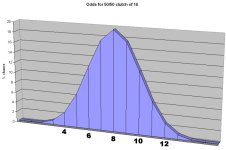bamboe32
New member
Real life genetics
What is the real average outcome when crossing double hets.
For instance crossing het amel & het aner with het amel & het aner.
The calculation says you will get 1/16 snow.
Meaning if you have 16 eggs you will get 1 snow.
But I am sure nature wil not look at those calculations and you will
get more or less snows.
What is the average everybody gets, so I know what to expect in real life
when crossing colors.
Rob.
What is the real average outcome when crossing double hets.
For instance crossing het amel & het aner with het amel & het aner.
The calculation says you will get 1/16 snow.
Meaning if you have 16 eggs you will get 1 snow.
But I am sure nature wil not look at those calculations and you will
get more or less snows.
What is the average everybody gets, so I know what to expect in real life
when crossing colors.
Rob.
Last edited:

